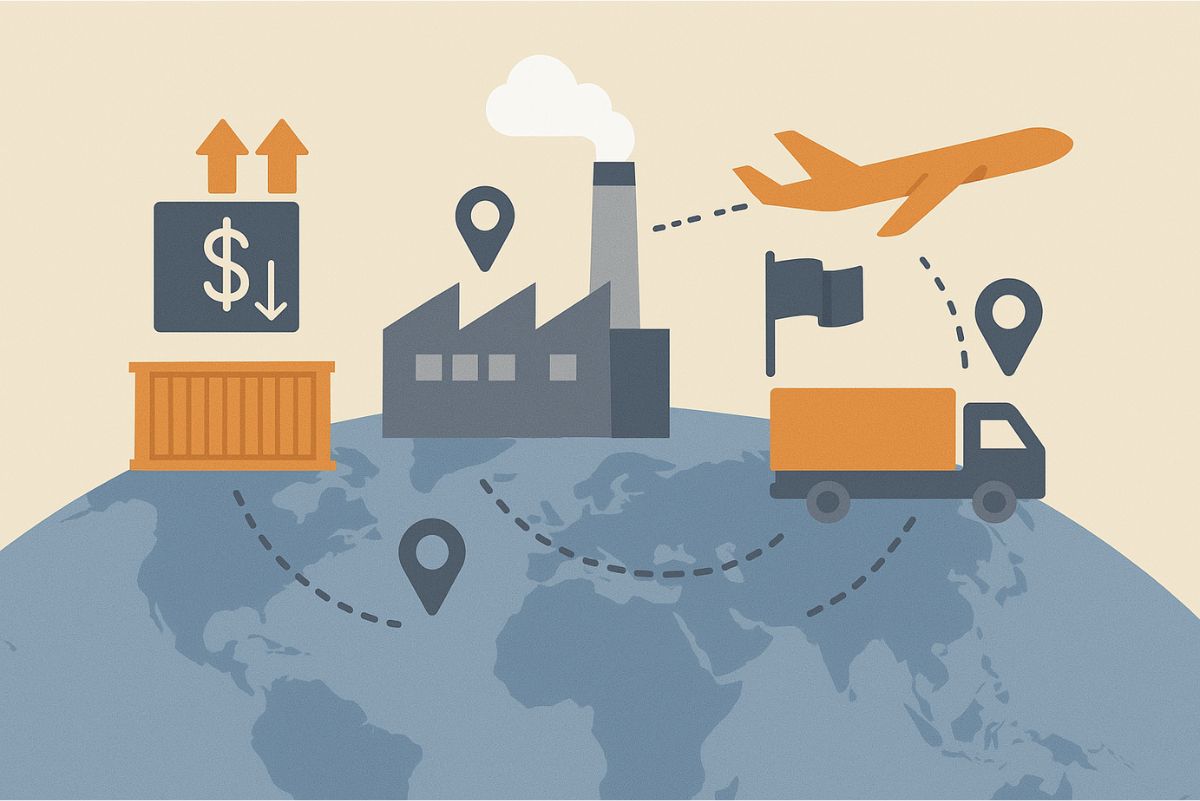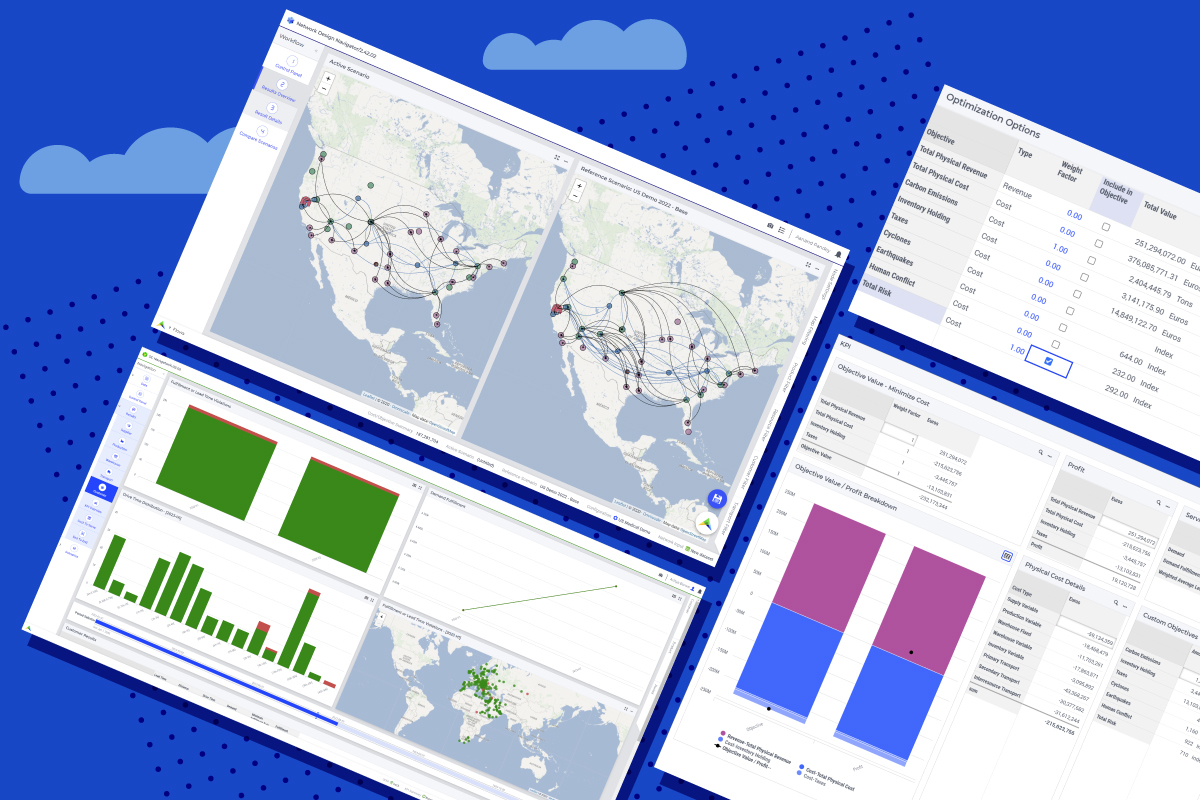Why Supply Chain Design Tools Are Now Essential To Boost Resilience
As the U.S. Directive to Secure Critical Supply Chains shows, resilience is the new mandate. In a previous blog, we addressed some techniques you can apply to increase your supply chain’s resilience in the short-term. However, there are some longer-term supply chain design choices you could consider to mitigate the impact of variability and disruption. To evaluate these choices, you need tooling that’s more advanced than spreadsheets. There’s more than one answer and you need to expand your field of vision to consider your extended supply chain. In this blog, we will discuss three strategies many companies are currently considering: multi-sourcing, nearshoring and postponement. We will also address how scenario modeling and mathematical optimization can help you evaluate when each makes sense.
New times call for new strategies
Historically, procurement has pursued the lowest-cost sources of supply. This often drove companies to have a single source in countries where manufacturing costs are low – typically the Far East. The flipside of that is that lead times are longer, given the multiple freight modes needed to get products into Western markets. So, the risk of disruption is higher. To mitigate this, many are now looking to diversify their sourcing and manufacturing strategies.
Multi-sourcing
In a recent Gartner survey, 63% of respondents are investing in multi-sourcing to “achieve greater resilience and/or agility.” Multi-sourcing is used to balance risks by having alternative sources of supply or back-up supply. Essentially, it’s about spreading risk over multiple suppliers. This can be part and component suppliers, as well as logistics suppliers. Surging container rates have shown that while producing in the Far East might be cheaper, securing affordable logistics capacity is getting more difficult. This means you need a total view of costs and capacity constraints, across both production and logistics resources, to properly assess opportunities for multi-sourcing.
In a recent Gartner survey, 63% of respondents are investing in multi-sourcing to “achieve greater resilience and/or agility.” – Tweet this
Nearshoring
Another strategy companies are currently considering is nearshoring. A survey conducted by Thomas in April 2020 showed that 64% of companies in North America were considering this option to mitigate trade risks. Near or re-shoring, as it is sometimes called, is about bringing sources of supply closer to the point of consumption. With nearshoring, unit purchase price goes up, but companies do gain compelling advantages. Lead times are reduced significantly, allowing them to be more responsive to changes in demand. The amount of inventory you need to hold also goes down, and buffers for supply variability can be trimmed. This means we can no longer focus only on unit costs and view procurement in isolation when evaluating nearshoring options. We need to focus on Return on Capital Employed (ROCE). Less interruptions of supply mean lower working capital is tied up, and you’re better able to meet demand. So, revenue goes up or is more protected. This puts you in a better position overall.
Postponement
Postponement is about increasing flexibility in your product mix by postponing your production decisions and making them closer to the point where you need to meet demand. This is a strategy that many equipment manufacturers have considered. As a simple example, let’s say you’re an electric oven manufacturer based in Europe and you sell 10 different kinds of ovens. All of them use the same control circuitry and heating elements, but they all have different doors and casings. Your postponement strategy might entail sourcing some of the standard components from China and procuring custom components closer to the final assembly location in Europe. If your assembly location is closer to the point of demand, you don’t need to commit to your product mix so far out. You’ve got more flexibility to decide which products to make based on margins and demand.
Challenges and opportunities
While multi-sourcing and nearshoring are about protecting your business from supply variability, postponement is about protecting it from demand variability. Multi-sourcing across different geographies or nearshoring are also great strategies to mitigate the risk from surprise changes in tariffs due to trade wars.
You may find that one of these strategies, or a combination of them, might be suited to increase resilience for your business. But as we discuss above, there is a lot of complexity involved. There’s also the challenge of visibility. In a recent Gartner study, less than 31% of “organizations have geographic location, and part and site data for Tier 2 and Tier 3 suppliers.” The figures for Tier 1 suppliers aren’t significantly better – only 38% have part and site visibility in this case.
According to Gartner, balancing the trade-offs between efficiency and resilience is also seen as a barrier by 54% of respondents. Taking short cuts or evaluating this trade-off with spreadsheets will probably make you fall back into old traps. The stakes are very high. That’s where scenario planning can truly help.
Scenario planning and optimization for supply chain network design
Gartner advises companies to “test market sensitivities and elasticities by using scenario planning.” They also recommend that you “reevaluate the scenario planning exercise periodically, as the environment is dynamic and in flux.” We would go even further. Yes, you do need the capability to look at scenarios, but you should also optimize those scenarios at the total business level. It’s important to understand the trade-offs and choices in a more holistic way. To do this well, you need special supply chain design software that helps you construct a model of your supply chain, define all the appropriate costs, compare scenarios side-by-side, and optimize to find the best solution. Having a perpetually ready model also allows you to test scenarios, optimized for a given objective, on a regular basis.
Yes, you do need the capability to look at scenarios, but you should also optimize those scenarios at the total business level. – Tweet this
How AIMMS customers use scenario planning to boost resilience
A global producer of computer chips uses AIMMS Network Design to explore risk scenarios around manufacturing and distribution locations, aiming to find alternative strategies for high-risk geographies.
Another one of our customers, a medical devices company in the United States, uses AIMMS Network Design to re-design their network as needed. They aim to reduce costs and improve customer service levels, as well as roll out new capacity to ensure resilience.
A U.S. furniture company uses AIMMS Network Design to explore alternative manufacturing locations that provide better security of supply, while maintaining costs and service levels.
A Spanish wholesale and retail distributor uses AIMMS Network Design to understand optimal network strategies for periods of high demand fluctuation. This enabled them to be resilient as the COVID-19 lockdown measures came into effect last year.
Curious about how you can gain resilience with scenario planning? Read more about AIMMS Network Design or contact us for more information.





